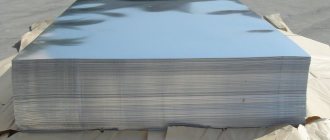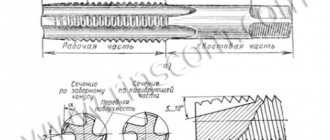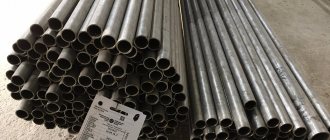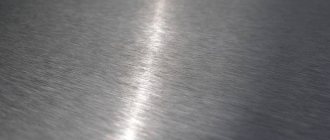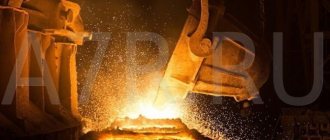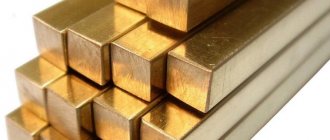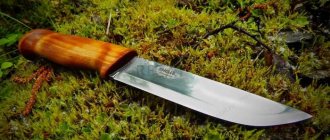The main advantage of stainless steel is its durability. This ensures ease of operation and maintenance. Stainless steel has corrosion resistance as well as excellent oxidation resistance.
When selecting stainless steel that must withstand corrosive environments, austenitic stainless steels are typically used. While possessing excellent mechanical properties, the large amounts of nickel and chromium in austenitic stainless steels also provide excellent corrosion resistance. In addition, many austenitic stainless steels can be welded and formed. The two most commonly used grades of austenitic stainless steel are 304 and 316 grades.
Chemical composition: find the main difference
Both grades belong to the non-magnetic, austenitic type of steel, are an iron-containing alloy and are not hardened by heat treatment. Each of these grades of stainless steel is resistant to corrosion, quite durable, and easy to form.
The difference primarily lies in the addition of molybdenum to alloy 316. Molybdenum further increases the material's corrosion resistance, making it ideal for more acidic environments. In addition, 316 steel has a longer service life than 304 steel when subjected to mechanical stress. This becomes obvious in the production of gears made from 304 and 316 steels - 316 steel is much less susceptible to wear.
| Compound | Content in AISI 304, % | Content in AISI 316, % |
| Chromium (Cr) | 18–20 | 16–18 |
| Nickel (Ni) | 8–10,5 | 10–14 |
| Molybdenum (Mo) | No | 2–3 |
| Manganese (Mn) | 2 | 2 |
| Silicon (Si) | 1 | 1 |
| Nitrogen (N) | 0,11 | 0,11 |
| Carbon (C), max. quantity | 0,08 | 0,03 |
| Phosphorus (P) | 0,045 | 0,045 |
| Sulfur (S) | 0,015 | 0,015 |
| Iron (Fe) | Remaining part | Remaining part |
Composition and application of Aisi 304
Austenitic stainless alloy, in addition to iron, contains the following additives,%:
- carbon up to 0.08, copper up to 1.0, manganese up to 2.0;
- chrome from 18 to 20;
- nickel 8.0 - 10.5.
The content of phosphorus and sulfur does not exceed hundredths of a percent.
Properties:
Metal sheets are produced by hot-rolled and cold-rolled methods. Metal products are used for the manufacture of:
- chimneys, ventilation systems;
- boilers, heat exchangers;
- chemical, medical equipment;
- building metal structures;
- pressure vessels;
- equipment for public catering establishments.
AiSi 304 steel is used to make welded, seamless pipes and fittings, such as bends.
The Russian analogue of the AiSi 304 alloy is steel grade 08Х18Н10, for AiSi 304L 03Х18Н11 is suitable.
Where is 316 and 304 stainless steel used?
304 is often used to make kitchen utensils, including sinks, pots and pans, and cutlery. This grade of stainless steel is well suited for storing food liquids, making tanks and cooking equipment. It is also used in heat exchangers, building facades, wheel covers, hose clamps, pressure vessels and other environmental applications in contact with fresh water.
316 stainless steel with added molybdenum is more resistant to aggressive environments than 304. 316 is more suitable for contact with seawater. Due to its greater oxidation stability, it is also widely used in the manufacture of petroleum refining equipment, fasteners, pulp and paper processing equipment, pharmaceutical equipment and surgical instruments.
Stainless steel AISI 316
AISI 316 has an almost identical composition to the AISI 304 brand. The difference is the percentage of elements and the addition of molybdenum (2-3%). This results in higher corrosion resistance. Therefore, it is often said that AISI 316 is an improved version of AISI 304
316 stainless steel stands up well to harsh chemicals and salt water. This makes it ideal for construction in marine and coastal areas. In addition, it is used for the manufacture of medical, chemical and oil refining equipment.
Stainless steel grades 304 and 316 in pumping equipment
These grades of steel are popular among pump manufacturers. However, in some cases, AISI 316 stainless steel is the only right solution. For example, for pumps that are used on ships for the purpose of sanitary supply with sea water or cooling equipment with sea water. AISI 316 is characterized by increased resistance to the formation of all types of corrosion in sea water. Also, in the petrochemical, oil refining or mining industries, when transporting aggressive liquids, it is worth giving preference to pumps with a body made of alloy 316 due to its greater durability and endurance compared to 304. Pumping equipment for the food and pharmaceutical industries cannot do without parts made of AISI 316 alloy, since upon contact with the environment, a film is formed on the surface of the metal, which prevents the appearance of rust and other defects throughout its entire service life.
So what should you choose? There is no clear answer. 304 steel is much cheaper than 316 and its choice in many cases is justified.
In what specific environment do you plan to use the equipment? If it is salty or sour, choose AISI 316. This is perhaps the main and most accurate recommendation. As mentioned, molybdenum matters. What will be the operating temperature of liquids in contact with metal? High temperatures accelerate corrosion. This means that a higher class is suitable - 316.
Cost is an important factor when choosing the right grade of stainless steel. But sometimes, having saved on equipment, you will lose more on maintenance, repairs and downtime in the future. Therefore, it is best to consult with specialists to understand which brand suits your requirements.
Ferritic stainless steels type 430
| Type | Compound | Density ρ, kg/m3 | Elastic modulus E, GPa | Coefficient of linear thermal expansion α, 1/K | Thermal conductivity coefficient λ, W/m K | Hardness HRC (HRB) | Hardness | Note |
| 430 | <0.12% C, 16-18% Cr, <0.75% Ni, <1.0% Mn | 7750 | 200 | 10,4 | 23,9 | (89) | 183 | Good corrosion resistance in nitric acid and some organic acids. In general, it has anti-corrosion properties similar to steel type 304. |
| 430F | <0.12% C, 16-18% Cr, <1.25% Mn | 7750 | 200 | 10,4 | 23,9 | (89) | 183 | Increased sulfur composition. Slightly worse anti-corrosion properties compared to 430 steel. |
Features and Benefits
Food grade stainless steel AISI steel, used for the manufacture of cookware and pipelines, has the following characteristics:
- resistance to aggressive chemical environments;
- ensuring long-term operation;
- anti-corrosion resistance of the entire surface;
- environmental Safety;
- compliance with migration standards for heavy metal salts;
- preservation of original properties, facilitating cleaning and maintenance.
When choosing a steel grade for food-grade stainless steel, the requirements of international standards defining the material, dimensions, quality and marking of products are taken into account, in particular DIN 11850-1999. How acceptable these characteristics are depends on the operating conditions; one can focus on the requirements for the properties of the metal that are provided by the alloying components.
Popular brands
In some cases, another brand that does not involve contact of products during prolonged exposure to aggressive environments may also fall under the concept of food grade. For the manufacture of dinnerware, steel is used, which has less anti-corrosion potential.
Types of stainless steel:
- 08Х18Н10 (AISI 304) is a common grade of food steel, stainless steel, used in the food industry, which does not interact with caustic soda and active sulfamine solutions. The unique composition 08Х18Н10 allows the possibility of electric polishing of products, provides strength against intergranular corrosion and a high level of weldability.
- 08X13 (AISI 409) is a popular grade of food grade stainless steel for the manufacture of kitchen utensils, characterized by high performance properties.
- 20Х13–40Х13 (AISI 420) – this composition is suitable for all types of household and industrial sinks, dishes for thermal and hygienic processing of products. Alloys of this type have excellent resistance to rust at high temperatures, are highly ductile and wear-resistant.
- 12X13 (AISI 410) – food grade stainless steel used in equipment in the field of winemaking, production of alcoholic beverages, and waste recycling. The alloy has increased heat resistance in a slightly aggressive environment, resistance to corrosion, and impact toughness.
Stainless steel types 12Х18Н10Т and 08Х18Н10Т are easy to process, weld, polish, and are used in medicine, food, alcohol, and oil industries.
Popular grades of food steel
| EN10088-2, EU | GOST, RF | AISI, USA | JIS, Japan | Germany, DIN |
| 1.4301 | 08X18H10 | 304 | SUS304 | XBCrNi18-10 |
| 1.4016 | 12X17 | 430 | SUS430 | XBCr17 |
| 1.4401 | 03X17H13M2 | 316 | SUS316 | X5CrNiMo17-12-2 |
| 1.4541 | 12X18H10T | 321 | SUS321 | XBCrNiTi18-10 |
Application
Areas of application of stainless steel:
- food industry, kitchen appliances; with an increase in living standards, the use of steel in everyday life and food production only increases;
- stainless steel is widely in demand in the chemical industry - tanks, containers, reactors, pipes (here food grade stainless steel 316 steel containing 6% molybdenum is acceptable);
- pulp and paper production uses stainless steel with molybdenum in its composition along with the AISI316 brand;
- electric power industry - burning oil, coal, gas - requires stainless steel products, ranging from small enterprises to energy complexes;
- environmental protection – steel is a consumable material when constructing new factories in accordance with environmental requirements;
- transport engineering - to ensure safety during the transportation of goods, in which containers made of AISI316L steel are widely used.
Martensitic stainless steels 410, 420, 431 and 440
| Type | Compound | Density ρ, kg/m3 | Elastic modulus E, GPa | Coefficient of linear thermal expansion α, 1/K | Thermal conductivity coefficient λ, W/m • K | Hardness HRC (HRB) | Hardness | Note |
| 410 | <0.15% C, 11.5-13.0% Cr, <1.0% Mn | 7750 | 200 | 9,9 | 24,9 | — | 225…388 | Basic martensitic steel. Moderate corrosion resistance in fresh water, food environments, low-concentration acids and alkalis. |
| 420 | <0.15% C, 12.0-14.0% Cr, <1.0% Mn | 7750 | 200 | 10,2 | 20,2 | — | 277…385 | A close analogue of 20X13. Moderate corrosion resistance in fresh water, food environments, low-concentration acids and alkalis. |
| 431 | <0.20% C, 15-17% Cr, 1.25-2.50% Ni, <1.00% Mn | 7750 | 200 | 10,3 | 24,9 | — | 262…444 | Anti-corrosion qualities are slightly lower than those of type 304 steel. |
| 440A | 0.65…0.75% C, 16-18% Cr, 0.75% Mo, <1.00% Mn | 7650 | 200 | 10,1 | 24,2 | 55 | — | Moderate corrosion resistance in fresh water, food environments, low-concentration acids and alkalis. |
| 440B | 0.75…0.95% C, 16-18% Cr, 0.75% Mo, <1.00% Mn | 7650 | 200 | 10,1 | 24,2 | 57 | — | Analogue 95Х18. Corrosion resistance equal to 304 steel. |
| 440C | 0.95…1.20% C, 16-18% Cr, 0.75% Mo, <1.00% Mn | 7650 | 200 | 10,1 | 24,2 | 59 | — | Corrosion resistance equal to 304 steel. |
The information was prepared based on materials from the sites:
https://www.azom.com/ https://www.bssa.org.uk/ https://www.suppliersonline.com/.
Brands of heat-resistant stainless steel
Consumers are mistaken in thinking that a stainless steel product will not collapse at elevated temperatures. For work in high-temperature conditions and under the influence of electric current, heat-resistant grades of food-grade stainless steel, characterized by creep and strength, are provided.
The creep indicator assumes the ability of a material to withstand the effects of continuous deformation under unfavorable conditions and high temperatures. Strength is responsible for withstanding external influences. Heating elements of furnaces exposed to temperatures of more than 550 degrees are made from such alloys. Regular steel forms ferrum oxide on the surface.
To withstand temperatures of 1000 degrees and above, alloys must contain at least 17% chromium and a certain percentage of nickel and other components. Heat-resistant steel contains chromium, aluminum, silicon, titanium, and the most durable steel contains nickel.
The following grades of stainless steel are heat-resistant: 20Х23Н18 (AISI 310), 10Х23Н18 (AISI 310S), 20Х20Н14C2 (AISI 309), 20Х25Н20С2 (AISI 314), 95Х18. They are used for the manufacture of combustion chambers, clamps, fasteners, and baskets in thermal furnaces.
Brands characterized by maximum heat resistance: 15Х25Т, 36Х18Н25С2, 15Х6СУ, 08Х17Т. The composition and marking of heat-resistant steels is regulated by GOST 5632-72.
Condensate coil
In making a coil for a distiller or moonshine still, some difficulties arise: when you try to bend the material, it flattens, and due to differences in the diameter of the tube along the entire length, a pressure drop occurs in the system and uneven condensation.
To maintain a stable diameter, the tube is filled with dry sand, compacted by tapping, and the ends are closed with cone-shaped wooden plugs. In this state, the coil is wound onto a piece of pipe. Then the plugs are burned out or drilled out, and after washing the coil is ready for use.



